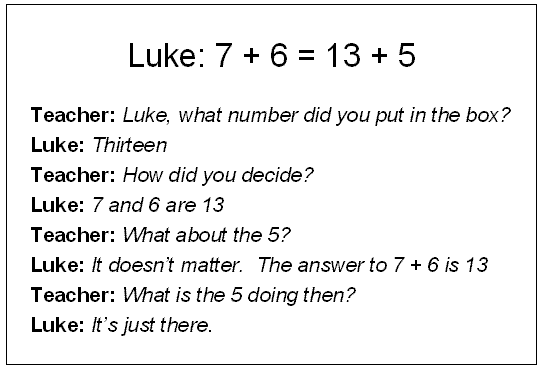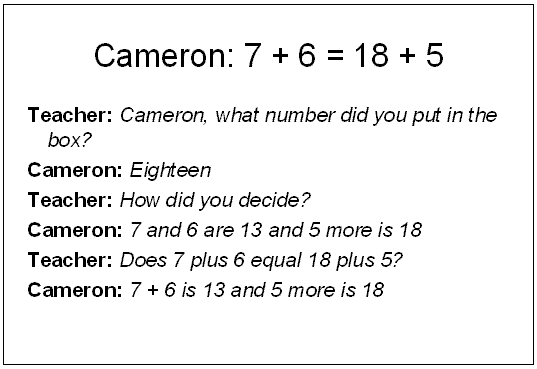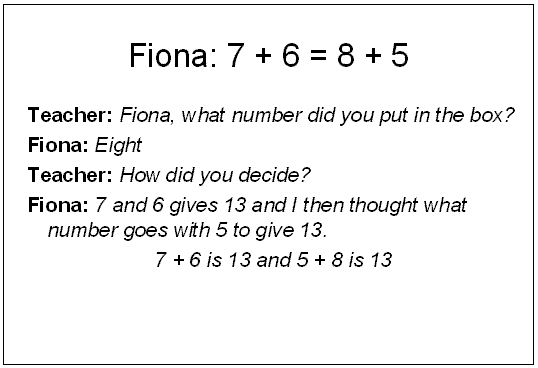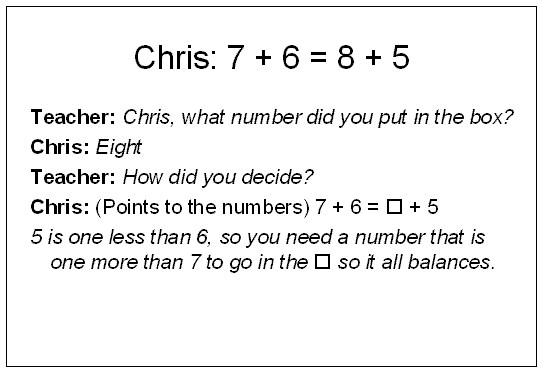The Meaning of the Equals Sign: 2.5
Supporting materials
Indicator of Progress
Students display an understanding of the equals sign in writing number sentences.
Many students do not understand the mathematical meaning of the equals sign: that the expressions on either side have the same value. Instead they believe that an equals sign indicates where to write an answer. This has implications for their work in the Number dimension and also for their success with algebra. From the first years of school, teachers are encouraged to stress the equality meaning of the equals sign.
See more about the equals sign.
Illustration 1: Students' interpretations of equals sign
Students were asked to find the missing number in the open number sentence 7 + 6 = □ + 5.
The first two students, Luke and Cameron, do not understand the meaning of the equals sign in the number sentence, believing that it is requiring them to write an answer to the expression on the left side.
By contrast, Fiona and Chris recognise that the two sides of the number sentence must be equal.
 |
 |
 |
 |
Illustration 2: Common incorrect uses of equals sign
The equals sign is often used with meanings other than equality, so the correct meaning needs emphasising.
For example, it often indicates just an association as in "MATHS = FUN" or "CONFIDENCE = SUCCESS".
Students often use it to indicate they have worked out an answer e.g. when calculating 3 × (14 + 36), students frequently write 14 + 36 = 50 × 3 = 150. This is a false mathematical statement, because it implies that 14 + 36 = 150.
As a diagnostic item, teachers can ask questions such as this:
Ed had to find how many points his AFL footy team would have if they had scored 8 goals and 5 behinds. Ed wrote:
8 × 6 = 48 + 5 = 53
Did Ed make a mistake? What advice would you give Ed?
Correct working: (8 × 6) + 5 = 53
Illustration 3: Calculators often use = as 'work it out'
Many calculators use the button labelled = for 'work it out now'. For example, if I enter 13 × 7 × 11 and press = , I will get the answer 1001.
Some more advanced calculators label the 'work it out' button as EXE (for execute), because they use = in its equality meaning.
Spreadsheets use = to indicate that a formula is being written.
Uses of = in the everyday world and in technology can reinforce students’ understanding of mathematical ideas, or limit conceptions. Pointing these conflicting uses out to students enables them to address this issue.
Teaching Strategies
Misuse of the equals sign is not difficult to change, but it is preferable to make sure students have good habits right from the start. Reinforcing the correct interpretation of the equals sign should occur regularly, with students being reminded in any contexts where it arises.
At every level, the usual reading of = by teachers and by students should be 'is equal to' rather than 'makes' or 'gives'.
Activity 1: Equations from a mat uses simple concrete materials in an open and creative way to prompt students to make equations of many different types. This activity can be undertaken from the earliest years of school, adjusting the numbers and relationships that are observed.
Activity 2: Matching card game with equivalent statements is a card matching activity, which reinforces the idea that there are many different ways of writing a mathematical sentence.
Activity 3: What goes in the box? shows expressions on both sides of a mathematical statement, emphasising the equality that it represents.
Activity 1: Equations from a mat
Make 'mats' out of Cuisenaire rods or other materials and write the resulting equalities in many ways. Cuisenaire rods are excellent because they are finely manufactured, but Unifix blocks or centicubes are good replacements. Make a rod of given length by connecting the right number of blocks or centicubes together.
For example, the 12-mat below could lead to many equations. It is called a 12-mat because it shows the length of 12 in many different ways. Students should aim for a variety of equations. They can check each other's work. Equations should be written with 'answers' on the right or left, and also without single number ('answers') on either side. Discussion and correction (if necessary) is essential.
Encourage two variations:
- Having the 'answer' (12) on either the right or the left (e.g. 12 = 3 × 4 as well as 3 × 4 = 12)
- Having an expression on both sides (e.g. 12 – 7 = 1 + 4)
 |
|
12 = 3 × 4, 3 × 4 = 12 (row 1) 3 + 3 + 3 + 3 = 12, 4 × 3 = 12 (row 2) 7 + 1 + 4 = 12, 12 – 7 = 1 + 4 (row 3) 4 + 4 + 4 = 10 + 2 (row 1 and row 4) 3 + 3 + 3 + 3 = 7 + 1 + 4 (row 2 and row 3) |
 |
|
This Cuisenaire mat activity can be carried out at many levels, using many different materials. Even a simple mat showing that a 2 rod and a 3 rod are the same length as a 5 rod leads to 8 variations of correct equations. 2 + 3 = 5, Even when students only know the + and = signs, they can write both 2 + 3 = 5 and 5 = 2 + 3, and in each case read the sign as 'is equal to' rather than 'gives' or 'makes'. |
Activity 2: Matching card game with equivalent statements
Students should recognise equality statements with 'hidden' numbers that are equivalent.
For example, 3 × 4 = □ ; 4 × □ = 12; □ = 3 × 4; □ × 3 = 12 are all equivalent mathematical statements.
Laminated cards with equality statements can be used for a game that students play in pairs or small groups, matching up and collecting sets of equality statements. A set of cards (PDF - 30Kb) can be downloaded, in which there are sets of 4 equivalent statements. Alternatively you can design your own relating to current Number topics.
How to play:
Remove one card from the deck, and deal out the remainder to the players. Players take it in turns to remove one card (without looking) from those held by the person on their right. They then try to make pairs of equivalent statements from the cards they hold. Once a pair is made it is set aside. A player's objective is to pair up all the cards in his/her hand.
Activity 3: What goes in the box?
The main purpose of this activity is to help students to recognise the meaning of the equals sign and that the two sides of the number sentence must be equal numbers.
The first part of the activity is an awareness-raising activity. Students then complete a set of number sentences to reinforce the learning. Click here for resource sheet: What goes in the box? (Word - 35Kb)
Part A. Discussion with teacher modelling the number sentence with concrete materials
Present this scenario:
Kim was asked to find the missing number in the number sentence 5 + 7 = □ + 9
Kim wrote 5 + 7 = 12 + 9
- Why do you think Kim wrote this?
- Work out the value of the left side.
- Work out the value of the right side.
- Is Kim’s complete number sentence true?
- What number would you put in the box to make the two sides equal?
Remember that both sides must equal 12 because 5 + 7 = 12.
Teachers can model the number sentences in this discussion, eg by making a rod from 5 yellow and 7 red Unifix and comparing that with a rod made of 9 blue Unifix. What do we need to make the second rod the same length as the first?
Part B. Resource Sheet Instructions
- Find the missing numbers in these number sentences. The first one is done for you to show you how to fill in the table.
- Remember that the left side and the right side of your number sentence must be equal to each other.
- Check by working out the left side and working out the right side. Are they equal?
|
|
My number sentence |
Left side |
Right side |
Equal? |
|
5 + □ = 3 + 4 |
5 + 2 = 3 + 4 |
5 + 2 = 7 |
3 + 4 = 7 |
Yes |
|
9 + □ = 6 + 8 |
|
|
|
|
|
9 + □ = 12 + 8 |
|
|
|
|
|
9 + □ = 12 + 6 |
|
|
|
|
|
10 + □ = 7 + 11 |
|
|
|
|
|
□ + 6 = 9 + 9 |
|
|
|
|
|
□ + 11 = 13 + 6 |
|
|
|
|
|
7 + 21 = □ + 11 |
|
|
|
|
|
10 +15 = □ + 8 |
|
|
|
|
|
23 + 7 = 18 + □ |
|
|
|
|
|
17 + 15 = 8 + □ |
|
|
|
|
References
Kieran, C. (1992). The Learning and Teaching of School Algebra, In D.A. Grouws (Ed.), Handbook of research on mathematics teaching and learning (pp. 390-419). New York: Macmillan.
MacGregor, M., & Stacey, K. (1999). A flying start to algebra. Teaching Children Mathematics. 6(2), 78-85.
Stacey, K and MacGregor, M (1997) Building Foundations for Algebra, Mathematics Teaching in the Middle School. 2 (4, February).
